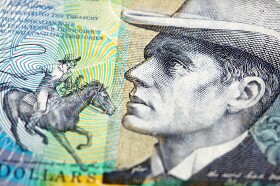The Australian dollar was soft today after data confirmed that Australia’s economy has entered a recession. The losses were limited, though, and the Aussie managed to remain flat against a range of peers. The currency had a muted reaction to yesterday’s monetary policy announcement from the Australian central bank.
The Australian Bureau of Statistics reported that gross domestic product shrank by 7.0% in the June quarter of this year on a seasonally adjusted basis. Not only the actual drop was worse than 6.0% predicted by analysts, but it also was the biggest drop in the history of the survey since 1959. Furthermore, it followed a 0.3% decline in the previous three months, meaning two consecutive quarters of contraction, which signals that the economy has entered a recession. It was the first recession in Australia in almost 30 years.
Treasurer Josh Frydenberg said after the report:
Today’s national accounts confirm the devastating impact on the Australian economy from COVID-19. Our record run of 28 consecutive years of economic growth has now officially come to an end. The cause? A once-in-a-century pandemic.
He was not totally pessimistic, though, stating:
Australia’s economic performance sits among the top of those developed nations as a result of our health and our economic plan to fight the virus.
Yesterday, the Reserve Bank of Australia decided to maintain its key interest rate unchanged at 0.25%, as was widely expected. But the RBA decided to expand its Term Funding Facility, announcing:
Today’s change brings the total amount available under this facility to around $200 billion.
The central bank noted that the economic downturn was not as bad as was previously expected:
In Australia, the economy is going through a very difficult period and is experiencing the biggest contraction since the 1930s. As difficult as this is, the downturn is not as severe as earlier expected and a recovery is now under way in most of Australia. This recovery is, however, likely to be both uneven and bumpy, with the coronavirus outbreak in Victoria having a major effect on the Victorian economy.
Nevertheless, the bank signaled that it is going to keep its monetary policy extremely accommodative:
The Board will maintain highly accommodative settings as long as is required and continues to consider how further monetary measures could support the recovery. It will not increase the cash rate target until progress is being made towards full employment and it is confident that inflation will be sustainably within the 2â3 per cent target band.
AUD/USD fell from 0.7371 to 0.7346 as of 8:44 GMT today. EUR/AUD was at 1.6151 after opening at 1.6157 and rising to the daily high of 1.6211. AUD/CAD dropped from 0.9627 to 0.9600.
If you have any questions, comments, or opinions regarding the Australian Dollar, feel free to post them using the commentary form below.
